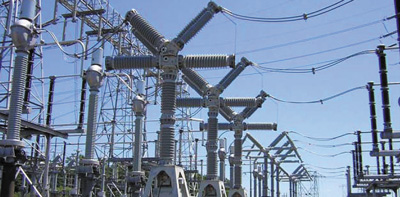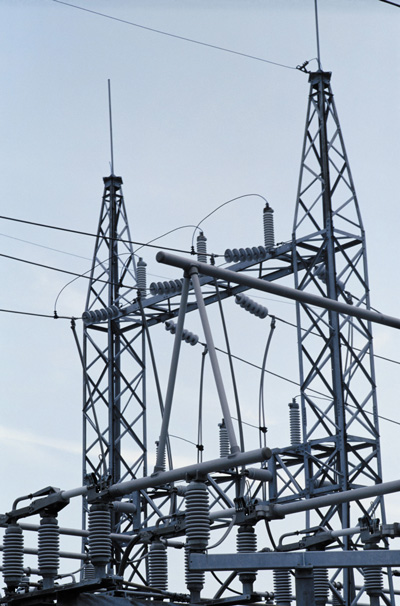
There is an increased focus on transmission and distribution investments to address aging and distressed infrastructure. Previously voluntary reliability programs under the North American Electric Reliability Council (NERC) are transitioning to mandatory reliability standards, requiring self reporting and imposing penalties for non- compliance. Utilities are placing a greater emphasis on real time, enterprise wide information to secure the right information and the right time to enhance reliability and to better manage asset management and operations and management.
Intelligent electronic devices (IEDs) being implemented in substations today contain valuable information, both operational and non-operational, needed by many user groups within the utility. An IED is any device that incorporates one or more processors with the capability to receive or send data/control from or to an external source (e.g., electronic multifunction meters, digital relays, controllers). IED technology can help utilities improve reliability, gain operational efficiencies, and enable asset management programs including predictive maintenance, life extensions and improved planning.
IEDs are a key component of substation integration and automation technology. Substation integration involves integrating protection, control, and data acquisition functions into a minimal number of platforms to reduce capital and operating costs, reduce panel and control room space, and eliminate redundant equipment and databases. Automation involves the deployment of substation and feeder operating functions and applications ranging from supervisory control and data acquisition (SCADA) and alarm processing to integrated volt/var control in order to optimize the management of capital assets and enhance operation and maintenance (O&M) efficiencies with minimal human intervention.
IEDs facilitate the exchange of both operational and non-operational data. Operational data, also called supervisory control and data acquisition (SCADA) data, are instantaneous values of power system analog and status points such as volts, amps, MW, MVAR, circuit breaker status, switch position. This data is time critical and is used to monitor and control the power system (e.g., opening circuit breakers, changing tap settings, equipment failure indication, etc.). Non-operational data consists of files and waveforms such as event summaries, oscillographic event reports, or sequential events records, in addition to SCADA-like points (e.g., status and analog points) that have a logical state or a numerical value. This data is not needed by the SCADA dispatchers to monitor and control the power system.


Utilities face the challenge of determining a standard integration architecture that meets its specific needs, can extract the desired operational and non-operational information, and deliver this information to the users who have applications to analyze the information. So how do utilities address this challenge? There have been many advances in substation integration and automation over the past 10 years. This article provides an overview of substation integration and automation fundamentals and a primer on best practices.
The ABCs of Substation Automation
Levels of Substation Automation - Substation integration and automation can be broken down into five levels. The lowest level is the power system equipment, such as transformers and circuit breakers. The middle three levels are IED implementation, IED integration, and substation automation applications. All electric utilities are implementing IEDs in their substations. The focus today is on the integration of the IEDs. Once this is done, the focus will shift to what automation applications should run at the substation level. The highest level is the utility enterprise, and there are multiple functional data paths from the substation to the utility enterprise.
Open systems - An open system is a computer system that embodies supplier- independent standards so that software may be applied on many different platforms and can interoperate with other applications on local and remote systems. An open system is an evolutionary means for a substation control system that is based on the use of nonproprietary, standard software and hardware interfaces. Open systems enable future upgrades available from multiple suppliers at lower cost to be integrated with relative ease and low risk.
Architecture Functional Data Paths - There are three primary functional data paths from the substation to the utility enterprise: operational data to SCADA systems, non- operational data to data warehouse, remote access to IED. The most common data path is conveying the operational data (e.g., volts, amps) to the utility’s SCADA system every 2 to 4 s. This information is critical for the utility’s dispatchers to monitor and control the power system. The most challenging data path is conveying the non-operational data to the utility’s data warehouse.
Substation Integration and Automation System Functional Architecture - The functional architecture includes three functional data paths from the substation to the utility enterprise, as well as the SCADA system and the data warehouse - Data Concentrator, SCADA interface, Router. The operational data path to the SCADA system utilizes the communication protocol presently supported by the SCADA system. The non-operational data path to the data warehouse conveys the IED non-operational data from the substation automation (SA) system to the data warehouse, either being pulled by a data warehouse application from the SA system or being pushed from the SA system to the data warehouse based on an event trigger or time. The remote access path to the substation utilizes a dial-in telephone or network connection.
New vs. existing Substations - The design of new substations has the advantage of starting with a blank sheet of paper. The new substation will typically have many IEDs for different functions, and the majority of operational data for the SCADA system will come from these IEDs. The IEDs will be integrated with digital two-way communications. Typically, there are no conventional remote terminal units (RTUs) in new substations. The RTU functionality is addressed using IEDs, PLCs, and an integration network using digital communications.
In existing substations, there are several alternative approaches, depending on whether or not the substation has a conventional RTU installed. The utility has three choices for their existing conventional substation RTUs: integrate RTU with IEDs; integrate RTU as another IED; retire RTU and use IEDs and PLCs as with new substation.
Equipment Condition Monitoring - Many electric utilities have employed ECM to maintain electric equipment in top operating condition while minimizing the number of interruptions. With ECM, equipment-operating parameters are automatically tracked to detect the emergence of various abnormal operating conditions. This allows substation operations personnel to take timely action when needed to improve reliability and extend equipment life. This approach is applied most frequently to substation transformers and high voltage electric supply circuit breakers to minimize the maintenance costs of these devices, as well as improve their availability and extend their useful life.
Substation Integration and Automation Technical Issues
• System Responsibilities – The system must interface with all of the IEDs in the substation. This includes polling the IEDs for readings and event notifications. The data from all the IEDs must be sent to the utility enterprise to populate the data warehouse or be sent to an appropriate location for storage of the substation data. The system processes data and control requests from users and from the data warehouse. The system must isolate supplier proprietary functionality by providing a generic interface to the IEDs. In other words, there should be a standard interface regardless of the IED supplier. The system should be updated with a report-by-exception scheme, where status-point changes and analog-point changes are reported only when they exceed their significant deadband.
• System Architecture – The types of data and control that the system will be expected to facilitate are dependent on the choice of IEDs and devices in the system. This must be addressed on a substation-by-substation basis. The primary requirement is that the analog readings be obtained in a way that provides an accurate representation of their values
• Level 1 Field Devices – Each electronic device (relay, meter, PLC, etc.) has internal memory to store some or all of the following data: analog values, status changes, sequence of events, and power quality. These data are typically stored in a FIFO (first in, first out) queue and vary in the number of events, etc., maintained.
• Level 2 Substation Data Concentrator – The substation data concentrator should poll each device (both electronic and other) for analog values and status changes at data collection rates consistent with the utility’s SCADA system (e.g., status points every 2 sec, tie-line and generator analogs every 2 sec, and remaining analog values every 2 to 10 sec). The substation data concentrator should maintain a local database.
• Level 3 SCADA System/Data Warehouse - All data required for operational purposes should be communicated to the SCADA system via a communication link from the data concentrator. All data required for non-operational purposes should be communicated to the data warehouse via a communication link from the data concentrator. A data warehouse is necessary to support a mainframe or client-server architecture of data exchange between the system and corporate users over the corporate WAN (wide area network). This setup provides users with up-to-date information and eliminates the need to wait for access using a single line of communications to the system, such as telephone dial-up through a modem.
• Substation Host Processor - The substation host processor must be based on industry standards and strong networking ability, such as Ethernet, TCP/IP, UNIX, Windows 2000 or XP, Linux, etc. It must also support an open architecture, with no proprietary interfaces or products. An industry-accepted relational database (RDB) with structured query language (SQL) capability and enterprise-wide computing must be supported. The RDB supplier must provide replication capabilities to support a redundant or backup database.
• Substation LAN - The substation LAN must meet industry standards to allow interoperability and the use of plug-and-play devices. Open-architecture principles should be followed, including the use of industry standard protocols (e.g., IEEE 802.x (Ethernet)). The LAN technology employed must be applicable to the substation environment and facilitate interfacing to process-level equipment (IEDs, PLCs) while providing immunity and isolation to substation noise.
• User Interface – The user interface in the substation must be an intuitive design to ensure effective use of the system with minimal confusion. An efficient display hierarchy will allow all essential activities to be performed from a few displays. It is critical to minimize or, better yet, eliminate the need for typing. There should be a common look and feel established for all displays. A library of standard symbols should be used to represent substation power apparatus on graphical displays. In fact, this library should be established and used in all substations and coordinated with other systems in the utility, such as the distribution SCADA system, the energy management system, the geographic information system (GIS), the trouble call management system, etc.
• Communications Interfaces - There are interfaces to substation IEDs to acquire data, determine the operating status of each IED, support all communication protocols used by the IEDs, and support standard protocols being developed. There may be an interface to the energy management system (EMS) that allows system operators to monitor and control each substation and the EMS to receive data from the substation integration and automation system at different periodicities. There may be an interface to the distribution management system with the same capabilities as the EMS interface.
• Data Warehouse - The corporate data warehouse enables users to access substation data while maintaining a firewall to substation control and operation functions. Both operational and non-operational data is needed in the data warehouse. To size the data warehouse, the utility must determine who the users of the substation automation system data are, the nature of their application, the type of data needed, how often the data is needed, and the frequency of update required for each user.
Protocol Fundamentals - A communication protocol allows communication between two devices. The devices must have the same protocol (and version) implemented. Any protocol differences will result in communication errors. The substation integration and automation architecture must allow devices from different suppliers to communicate (interoperate) using an industry-standard protocol. The utility has the flexibility to choose the best devices for each application, provided the suppliers have designed their devices to achieve full functionality with the protocol.
Protocol Considerations - There are two capabilities a utility considers for an IED. The primary capability of an IED is its standalone capabilities, such as protecting the power system for a relay IED. The secondary capability of an IED is its integration capabilities, such as its physical interface (e.g., RS-232, RS-485, Ethernet) and its communication protocol (e.g., DNP3, Modbus, IEC 61850 MMS). Today utilities typically specify the IEDs they want to use in the substation rather than giving a supplier a turnkey contract to provide the supplier’s IEDs only in the substation. However, utilities typically choose the IEDs based on the IED’s standalone capabilities only, without considering the IED’s integration capabilities.
• Utility Communication Architecture - The use of international protocol standards is now recognized throughout the electric utility industry as a key to successful integration of the various parts of the electric utility enterprise. One area addresses substation integration and automation protocol standardization efforts. These efforts have taken place within the framework provided by the Electric Power Research Institute’s (EPRI’s) UCA.
• Merger of UCA with IEC 61850 - In 1995 IEC TC 57 Working Groups 10, 11 and 12 began developing IEC 61850, Communication Networks and Systems in Substations, which defines a standard protocol for substation control and protection, including alternate communications stacks to be used with a standard substation-defined object-oriented user layer. The ten existing parts of 61850 have been issued as international standards, although future revisions are likely as field installations reveal issues and shortcomings. In 2001, the developers of 61850 and UCA agreed to merge the standards and get to one international standard, a critical objective for both standards projects.
• IEC 61850 - The continuing development of UCA2/MMS has ceased as suppliers refocus on implementing IEC 61850 versions of this LAN-based automation design. Meanwhile, supplier-utility demonstration projects of UCA2/MMS have been upgraded to IEC 61850 or were converted to DNP3. There are very few SA Systems in service today that utilize UCA2/MMS. The trial UCA2/MMS installations included significant amounts of custom relay and IED programming and adaptation to make the sophisticated new technology work in its first practical installations.

• Distributed Network Protocol - The development of DNP was a comprehensive effort to achieve open, standards-based interoperability between substation computers, RTUs, IEDs, and master stations (except inter-master-station communications) for the electric utility industry. The short-term benefits of using DNP are: interoperability between multi-supplier devices; fewer protocols to support in the field; reduced software costs; no protocol translators needed; shorter delivery schedules; less testing, maintenance, and Training; improved documentation; independent conformance testing; support by independent user; group and third-party sources (e.g., test sets, source code). In the long term, further benefits can be derived from using DNP, including: easy system expansion; long product life; more value-added products from suppliers; faster adoption of new technology; major operations savings.
Choosing the Right Protocol - There are several factors to consider when choosing the right protocol for the application. First, determine the system area with which you are most concerned with, such as the protocol from a SCADA master station to the SCADA RTUs, a protocol from substation IEDs to an RTU or a PLC, or a LAN in the substation. Second, determine the timing of your installation, e.g., six months, 18 to 24 months, or three to five years. In some application areas, technology is changing so quickly that the timing of your installation can have a great impact on your protocol choice.
Communications Protocol Application Areas - There are various protocol choices depending on the protocol application area of your system. Protocol choices vary with the different application areas. Different application areas are in different stages of protocol development and industry efforts. The status of development efforts for different applications will help determine realistic plans and schedules for your specific projects.
• Within the Substation - The need for a standard IED protocol dates back to the late 1980s. IED suppliers acknowledge that their expertise is in the IED itself – not in two-way communications capability, the communications protocol, or added IED functionality from a remote user. Though the industry made some effort to add communications capability to the IEDs, each IED supplier was concerned that any increased functionality would compromise performance and drive the IED cost so high that no utility would buy it. Therefore, the industry vowed to keep costs competitive and performance high as standardization was incorporated into the IED.
• Substation-to-Utility Enterprise - This is the area of traditional SCADA communication protocols. The Data Acquisition, Processing and Control Systems Subcommittee of the IEEE PES Substations Committee began developing a recommended practice in the early 1980s in an attempt to standardize master/remote communications practices. At that time, each SCADA system supplier had developed a proprietary protocol based on technology of the time. These proprietary protocols exhibited varied message structures, terminal-to-data circuit terminating equipment (DCE) and DCE-to-channel interfaces, and error detection and recovery schemes.
Make Decisions with the Future in Mind - As we look to the future, it seems the time between the present and the future is shrinking. When a PC bought today is made obsolete in six months by a new model with twice the performance at less cost, how can you protect the investments in technology you make today? Obviously, there is no way you can keep up on a continuous basis with all the technology developments in all areas. You must rely on others to keep you informed, and who you select to keep you informed is critical. With every purchase, you must evaluate not only the supplier’s present products but also its future product development plans.
• Does the supplier continuously enhance and upgrade products?
• Is the supplier developing new products to meet future needs?
• Do existing products have a migration path to enhanced and new products?
Selecting the right supplier will ensure you stay informed about new and future industry developments and trends and will allow you to access new technologies with the least impact on your current operation.
About the Author
John D. McDonald, P.E., is Vice President, Automation for KEMA, Inc., with 32 years of experience in the electric utility industry. John is currently assisting electric utilities in substation automation, distribution SCADA, communication protocols and SCADA/DMS.










